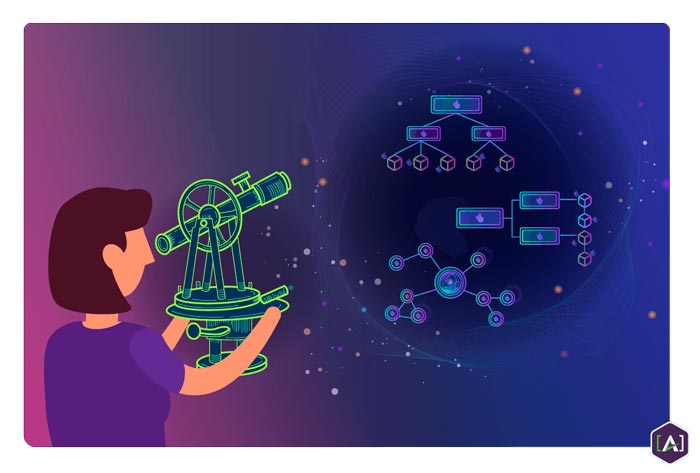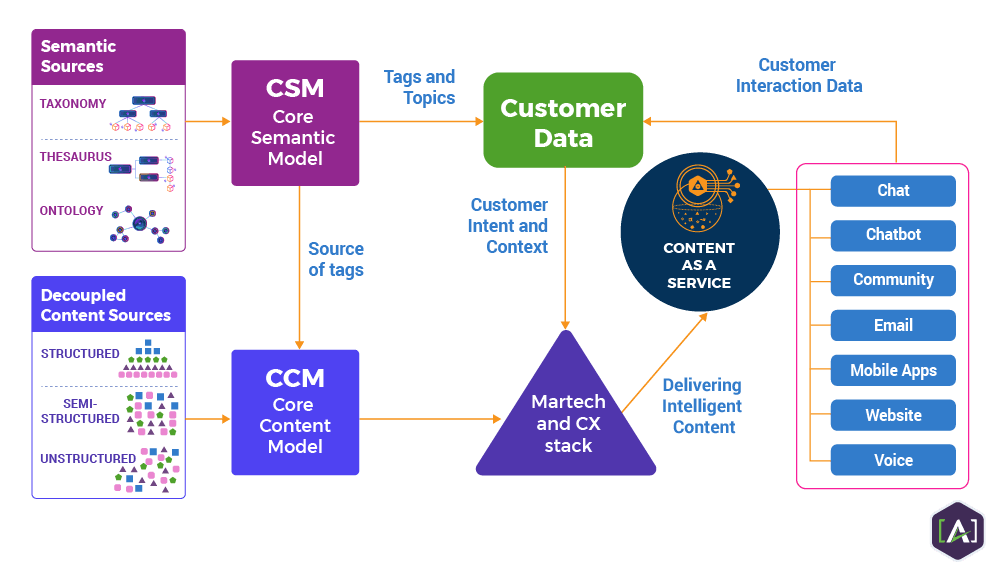To read the previous entry in this series from the [A] Semantics team for more context, click here.
Many organizations have at least a growing awareness of the need to use semantics to control an organization’s terms. Taxonomies and tag systems exist in even small organizations and isolated departments. However, few have the staff expertise to transform existing vocabularies and taxonomies into a cohesive semantic system that can be used across multiple groups in the enterprise.

A
Core Content Model is an essential ingredient for content intelligence, being a powerful tool for defining the structure of an organization’s content assets. But on its own, a CCM does not convey any information about the meaning or context of the organization’s content. In other words, the information lacks a
semantic interpretation.
Without a semantic interpretation, the CCM is merely a model of the pure structure of the organization’s content assets. Put in terms of a
Content Supply Chain, a content management system plays the crucial role of sending content to the different channels that an organization uses to deliver content. Without a semantic layer to interpret the organization’s content, the content management system cannot effectively deliver content to the right channel or consumption assembly.
In many organizations, early semantic forms are found in “tags” in marketing or support departments. Tags matter for tracing marketing attributions, or support topics, but they also matter for targeting content out for dynamic assembly. All of the tags need to work together, and the semantic fabric brings tags together with other semantic sources within a
Core Semantic Model.
Of course, the organization’s authors, editors, and publishers bring their own meaning and interpretation to the content. That’s a normal part of making meaning between content and humans.
But if 100% subjective human interpretation is needed every time to give the content meaning, then the content itself is not intelligent. This leads to content that is ambiguous, hard to find, and difficult to access across the organization. As a result, many organizations are in a situation where content is expensive to create, but its value is not fully leveraged. In other words, the ability of teams across the company to use existing content is severely limited, leading either to content that is expensively replicated or teams acting without the content they need to perform at their most effective level.
Further, if content authors, editors, and publishers merely use their own interpretation, they will tend to tag and label content in inconsistent ways. This leads to confused customers and frustrated employees unsure of how to find or interpret an organization’s content, resulting in lost sales and less efficiency. In order to realize the full investment in content, it needs to be enhanced with semantics.

Search engine optimization (SEO) is driven entirely by semantics, but the lack of semantics practices is often filled by using clunky and inconsistent “keywords” or “tags” on an ad-hoc, page-by-page basis. Generating structured data for search engines is often a manual and tedious process, not integrated with semantic or structural systems.
Thus, all companies have a need for content to be semantically enhanced, though, most don’t have a plan in place or have experts on staff who can strategically and tactically plan to integrate semantics. Most companies today also lack the infrastructure to govern and control the semantics of their content assets. Semantics makes life easier for so many different people across an organization, but because it’s an invisible function today, semantics gets ignored and underfunded. This will change because it must in order to create intelligent systems.
The Solution
The solution is to build a semantic map of the meaning territory. We need to build a formal model of the meaning and context of an organization’s content. So that, aside from building and maintaining the model, the semantic interpretation of the organization’s content no longer relies exclusively on human intervention. This is where the Core Semantic Model comes in, acting as the comprehensive and integrated model of the semantics underpinning an organization’s content assets.

Adding semantics to existing content structures greatly enhances the content’s ability to be delivered to multiple users across multiple channels. The semantics facilitates this delivery by making content assets more easily found and accessed across different domains and systems.
A CSM achieves this by enforcing a consistent tagging and labeling system, so that navigating and accessing content is as seamless and automatic as possible. Using existing taxonomies provides a jump start to creating a semantics solution, in addition to integrating existing content structures — such as existing labeling and navigation — into a semantics “layer.”
The Core Semantic Model establishes a reliable and shared basis for tagging content and data. When built into a semantics software platform, the CSM becomes the “source of truth” for all semantics, providing tags and topics that get annotated onto both modular content objects and customer data.
By modeling crucial semantic relationships between terms, a content supply chain can be set up to make relevant content immediately accessible to customers and employees. For example, by modeling the fact that two products are typically used with one another, when a customer purchases one product, relevant information about the other product can be made readily available to that customer.
The marketing technology (Martech) software stack almost always includes the delivery of content-driven customer experiences that rely on a taxonomy of tags. Sometimes these are called “categories”, or “attribution variables”, or simply “tags”. Regardless of the form or the name, semantics are essential to matching content to customer intent.
The CSM gets more comprehensive and more integrated over time, like any mapping system does. Think about the process of going from no maps, to rudimentary ones, to comprehensive flat maps and atlases, to digital multilayered maps, to interactive, intelligence-driven maps. It’s the same territory, made increasingly more accessible to humans and machines by constantly improving upon the maps.
The first step towards intelligence starts with creating even a simple starting point for a semantic model of the domain.
Contact Us for a Free Consultation.